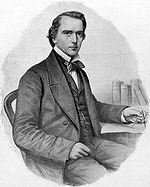- Charles Tilston Bright
-
Sir Charles Tilston Bright 
Charles Tilston Bright c. 1858Born 8 June 1832
Wanstead, EssexDied 3 May 1888 (aged 55)
Abbey WoodNationality United Kingdom Known for transatlantic telegraph cable Sir Charles Tilston Bright (8 June 1832 – 3 May 1888) was a British electrical engineer who oversaw the laying of the first transatlantic telegraph cable in 1858, for which work he was knighted.
Born on 8 June 1832 in Wanstead, Essex he was educated at Merchant Taylors' School.[1]
At fifteen he became a clerk for the Electric Telegraph Company and as his talent for electrical engineering became evident, he was appointed engineer to the Magnetic Telegraph Company in 1852. In that role he supervised the laying of lines in the British Isles, including in 1853 the first cable between Scotland and Ireland, from Portpatrick to Donaghadee, when he was just 21. This work, and the successful laying of other submarine cables, suggested to others that it might be possible to lay a cable across the Atlantic from Ireland to North America.
Joining with Cyrus West Field and J. W. Brett, who controlled the Newfoundland Telegraph Company, Bright helped organize the Atlantic Telegraph Company in 1856 to develop a transatlantic cable, with himself as engineer-in-chief; Wildman Whitehouse soon joined them as chief electrician. After two failed attempts in August 1857 and three more in June 1858, Bright successfully accomplished what to many had seemed an impossible feat, completing the first Atlantic cable from Trinity Bay, Newfoundland, to Valentia, Ireland, on 5 August 1858. Bright was knighted in Dublin just a few days later. Though widely hailed as the wonder of the age, the 1858 cable failed after only about a month of fitful service, a victim of hasty manufacture and the excessive signaling voltages used by Whitehouse. Sir Charles Bright emerged from the debacle with his reputation largely intact and went on to supervise the laying of successful cables in the Mediterranean, the Persian Gulf, and the Caribbean. He also served as a consultant on renewed efforts to span the Atlantic, which in 1866 resulted not only in the completion of the first lasting transatlantic cable, but in the recovery and completion of a cable that had snapped during laying in 1865.
Bright formed a partnership with Josiah Latimer Clark in 1861 and together they introduced numerous improvements in the manufacture, testing, and operation of submarine cables. They were strong advocates of establishing a unified system of electrical units, and a number of the proposals they made in a paper presented to the British Association for the Advancement of Science in 1861 were later taken up by the British Association Committee on Electrical Standards and formed the foundations of the system of ohms, amps, and volts still in use today.
From 1865 to 1868 Bright was Liberal MP for Greenwich and in 1887 he was elected president of the Society of Telegraphy Engineers and Electricians (later the Institution of Electrical Engineers). Bright died on 3 May 1888, at Abbey Wood, near London. His son Charles Bright was also a noted cable engineer and historian of the subject.
References
External links====References
- ^ A. C. Lynch, ‘Bright, Sir Charles Tilston (1832–1888)’, Oxford Dictionary of National Biography, Oxford University Press, 2004; online edn, Jan 2011 accessed 7 Feb 2011.
- Hansard 1803–2005: contributions in Parliament by Charles Tilston Bright
- Hounslow Guardian article
Parliament of the United Kingdom Preceded by
David Salomons
William AngersteinMember of Parliament for Greenwich
1865 – 1868
With: David SalomonsSucceeded by
David Salomons
William Ewart GladstoneCategories:- 1832 births
- 1888 deaths
- Old Merchant Taylors
- People from Wanstead
- English engineers
- British electrical engineers
- History of telecommunications
- Members of the United Kingdom Parliament for English constituencies
- Liberal Party (UK) MPs
- Knights Bachelor
- UK MPs 1865–1868
- Telegraphy
Wikimedia Foundation. 2010.
